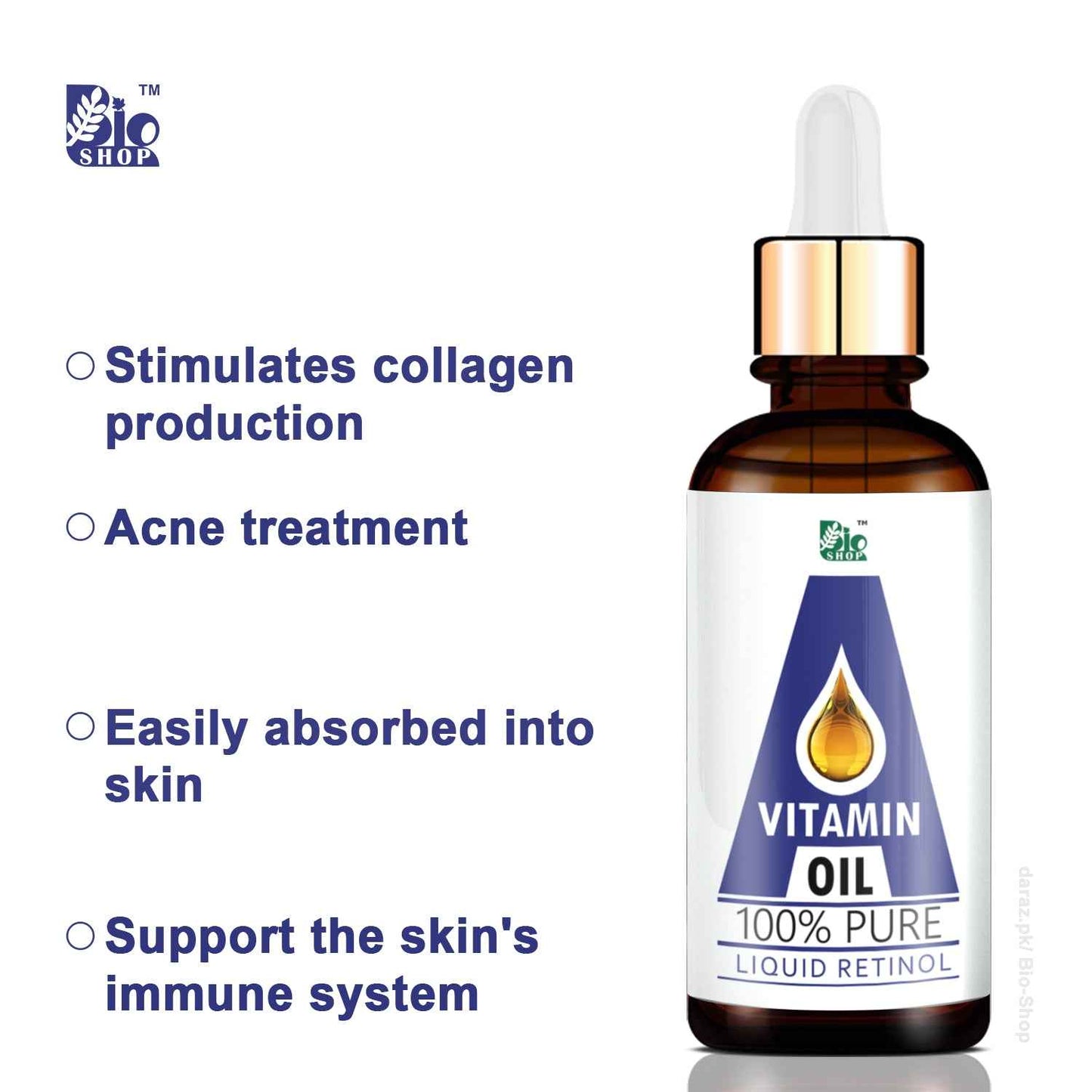Bio Shop
Vitamin A Oil
Vitamin A Oil
Key Functions: Enhances cell turnover, reduces wrinkles, and improves overall skin texture.
Couldn't load pickup availability






Explore
Information About Vitamin A Oil
✅ Key Features
- Rich in Retinyl Palmitate – a stable form of Vitamin A
- Supports collagen production and reduces fine lines
- Improves uneven tone, texture, and pigmentation
- Fat-soluble and ideal for oil-based skincare formulas
- Acts as a gentle retinoid alternative for sensitive skin
🔬 Description
🧴 Vitamin A Oil (Retinyl Palmitate)
Vitamin A Oil (commonly in the form of Retinyl Palmitate) is a skin-rejuvenating cosmetic ingredient used in anti-aging, anti-acne, and skin-brightening formulations. It encourages skin cell turnover, softens roughness, and boosts the skin's elasticity. As a gentler derivative of retinoids, it is more stable and better suited for daily-use skincare products like night serums, under-eye creams, and facial oils.
📊 Technical Data
INCI Name: Retinyl Palmitate
CAS Number: 79-81-2
Solubility: Oil-soluble
Add Phase: Oil phase (cool down below 40°C)
pH Stability: Not applicable in waterless/oil-based formulas
Processing Temperature: Below 40°C
Appearance: Pale yellow viscous oil
Odor: Mild to odorless
Molecular Formula: C36H60O2
Molecular Weight: 524.87 g/mol
Flash Point: ~160°C
Density: ~0.93 g/cm³
Chemical Type: Vitamin derivative (ester of retinol)
Functional Groups: Ester
Primary Cosmetic Uses: Anti-aging serums, creams, face oils, eye creams, lip serums
🧪 Recommended Usage
- Usage Rate: 0.5% – 2%
- Recommended Products: Serums, night creams, under-eye treatments
- Storage: Store in a cool, dark place; UV sensitive
💡 Pro Tip
For a gentle night serum, mix Vitamin A Oil at 1% with Squalane, Jojoba Oil, and a few drops of Vitamin E. Avoid sunlight after application and always follow with sunscreen during the day.
👩🔬 Skin Type Compatibility
✔️ Normal Skin
✔️ Oily Skin
✔️ Combination Skin
✔️ Aging/Mature Skin
➖ Sensitive Skin (Patch test required)
❌ Avoid during pregnancy unless advised by a doctor
🧴 Formulation Ideas
- Anti-Wrinkle Night Serum
Blend 1% Retinyl Palmitate with 90% Squalane and 9% Jojoba Oil. Add 0.5% Vitamin E to stabilize. - Brightening Eye Cream
Use 0.5–1% Vitamin A Oil in a nourishing cream base with peptides and hyaluronic acid. - Anti-Acne Facial Oil
Combine Vitamin A Oil with tea tree oil and grapeseed oil. Use as a spot treatment. - Retinol Lip Treatment
Blend into balm base at 0.5% with shea butter and Vitamin C ester for softening lips. - Firming Body Butter
Add 1% Vitamin A Oil into whipped mango/shea body butter for enhanced elasticity.
💧 Cosmetic Suitability:
Serums
⭐⭐⭐⭐✨ – Between Good and Excellent
🟩🟩🟩🟩🟨
Creams & Lotions
⭐⭐⭐⭐☆ – Good
🟩🟩🟩🟩⬜
Toners
☆☆☆☆☆ – Not Applicable
🟥⬜⬜⬜⬜
Face Masks
⭐⭐⭐⭐☆ – Good
🟩🟩🟩🟩⬜
Cleansers
⭐⭐⭐☆☆ – Moderate
🟨🟨🟨⬜⬜
Hair Masks
☆☆☆☆☆ – Not Applicable
🟥⬜⬜⬜⬜
Deodorants
☆☆☆☆☆ – Not Suitable
🟥⬜⬜⬜⬜
Eye Creams
⭐⭐⭐⭐☆ – Good
🟩🟩🟩🟩⬜
Shampoos
☆☆☆☆☆ – Not Applicable
🟥⬜⬜⬜⬜
Soaps
⭐⭐☆☆☆ – Fair
🟧🟧⬜⬜⬜
Conditioners
☆☆☆☆☆ – Not Applicable
🟥⬜⬜⬜⬜
Lip Balms
⭐⭐⭐☆☆ – Moderate
🟨🟨🟨⬜⬜
Body Butters
⭐⭐⭐⭐☆ – Good
🟩🟩🟩🟩⬜
Ointments
⭐⭐⭐⭐☆ – Good
🟩🟩🟩🟩⬜
❓ FAQs
Q1: Is Vitamin A Oil safe for daily use?
Yes, in low concentrations (0.5–1%). Avoid direct sunlight or use at night.
Q2: Can it be used in water-based formulas?
No. It is oil-soluble and should only be used in oil or emulsified formulations.
Q3: Is it suitable for sensitive skin?
Generally yes, but patch testing is recommended.
📂 Documentation
Upon request, we will provide.
Where Can You Safely Use Vitamin A Oil
Discover how Vitamin A Oil performs across different products — rated for safety, stability, and effectiveness.







